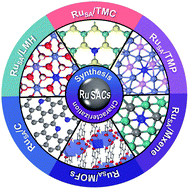Emerging ruthenium single-atom catalysts for the electrocatalytic hydrogen evolution reaction
Abstract
The electrocatalytic hydrogen evolution reaction (HER) is an efficient approach for producing hydrogen, which is a sustainable and eco-friendly energy carrier. Ruthenium-based HER catalysts are considered good alternatives to commercial platinum-based ones, because they have similar hydrogen bonding energy, lower water decomposition barrier and considerably lower price. Recently, emerging Ru single-atom catalysts (SACs) have shown greater advantage for HER than Ru nanoparticles, owing to their high atomic utilization efficiency, catalytic activity and selectivity. This review provides a comprehensive summary of the recent development of Ru SACs for HER applications. An overview of synthesis strategies, atomically resolved characterization methods and electrocatalytic studies with different support materials is provided. Finally, the unresolved challenges in the development of Ru SACs for industrial HER applications are discussed, and future research priorities are proposed. This review is expected to guide the rational design, appropriate fabrication, and performance optimization of advanced Ru SACs toward HER applications.

- This article is part of the themed collection: Editor’s Choice 2023: Advancing electrocatalysts for a sustainable future.


 Please wait while we load your content...
Please wait while we load your content...